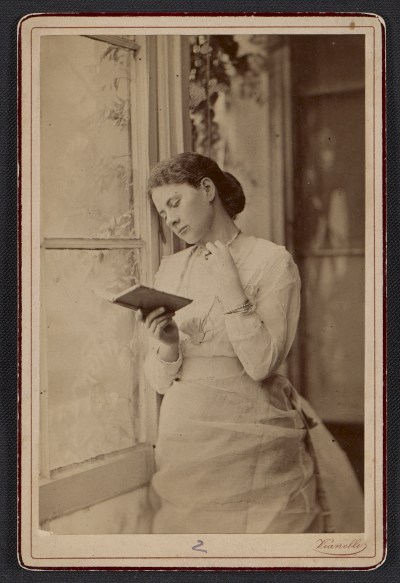Today is the birthday of Maria Oakey Dewing, born October 27, 1845. Her rich, passionate painting, Rose Garden, is a visitor favorite in Crystal Bridges’ permanent collection. Born Maria Richards Oakey, Dewing began her artistic career at the age of 17. She studied at Cooper Union School of Design and the Antique School of National Academy of Fine Arts. She studied with John La Farge, and her work was influenced by La Farge’s fascination with Japanese aesthetics. She was one of the founders of the Art Students League of New York and was well respected in the New York art world.

Maria Oakey Dewing, photographed by Fratelli Vianelli. This image is among the Dewey family papers in the Archives of American Art at the Smithsonian Institution.
Now known primarily for her flower paintings, in her early career Maria also painted portraits and still lifes. In 1881 she married the artist Thomas Wilmer Dewing, whose career was less well-established. At that time her work turned increasingly toward still life and then to paintings of flowers made directly from the garden. It is possible that she made this change of direction in order to avoid competing with her husband, who was also a portrait painter—she would not be the first female artist whose career was overshadowed by that of a husband or lover—yet she may also have made a choice to focus her artistic efforts elsewhere. Dewing was an early convert to Modernism, and in an article published in Art and Progress in 1915 she wrote: “The flower offers a removed beauty that exists only for beauty, more abstract than it can be in the human being, even more exquisite. One may begin with the human figure at the logical and realistic, but in painting the flower one must even begin at the exquisite and distinguished.”
Whatever her reasons for choosing flowers over figures, there can be no doubt that Dewing truly and passionately loved the garden. She and her husband spent many summers in the Cornish Art Colony in Cornish, New Hampshire, and they kept a garden there, where Maria conducted her intense studies of botany and the anatomy of the flower for her work. Her passion for the garden comes out also in her writing, as in this passage from “Flower Painters and What the Flower Offers to Art,” in which she describes the bloom of a lily as if she is watching it unfurl in a time-lapse video:
“Who, without long acquaintance, can tell the color of a bed of auratum lilies? The long buds, with no calyx, growing right out of the stalk, faintly tinged with the same green, designed with an elegance fit for sculpture, merely clinging together, the long petals form the bud. Presently one stirs, a rift in the smooth form. Soon all the petals, gently stirring, make a little trumpet mouth at the end of the bud. One by one they burst loose, a puff of fragrance escapes, each petal curls back against the stem, the splendid stamins float out, the round ended polished pale green pistil shows itself and the golden band that every petal bears.”
Only close and long-time observation of the lily in the process of blooming could have produced such an elegant and accurate description. It is this same passion for close observation that gives Dewing’s flower paintings such depth and richness of detail and perspective. Sitting in front of Rose Garden, you get a sense of crouching low, viewing the rose canes and intertwining morning glory vines as if from the deep heart of an overarching wild bramble of bloom.
Of capturing the riotous beauty of nature on canvas, Dewing wrote: “It is not possible to succeed….the exhaustive expression of the inexhaustible suggestion of nature can never be attained.” Still, it seems to me that with Rose Garden, she came pretty darned close.





